Diary of a Master of Wine in Provence
Solidarité – “Le coeur des chefs”
by Elizabeth Gabay, MW
Written in Saint Martin Vésubie 18th October 2020. I am often described as living in Provence – which makes sense being a rosé specialist, but I actually live in the southern Alps, just over 40 miles north of Nice on the Italian border in a small medieval town called Saint Martin Vésubie. Originally on the salt trade route between Nice and Turin, it became a fashionable tourist location from the late 1900s when it was dubbed La Suisse Niçoise. The village was in the news on 30th August when the second day of the Tour de France whizzed through. It felt like fiesta time as we lined the main road, cheering on the cyclists. Just over a month later we were in the news again, for very different reasons.
Over the 30th September to 1st October 2020, Storm Alex swooped down from Brittany in northwest France, arriving in the far southeastern corner of France, and my village Saint Martin Vésubie, by the morning of 2nd October. Throughout the day of the 1st we had received weather alerts on phones and email. “Move your car to somewhere safe”, “make sure you are prepared for flooding”. The messages increased, but, living at 1000m, we are used to the water running down the mountain and it is the lower villages which are hit, rarely us. This may sound more familiar to those living in the path of hurricanes, but not here. We have little earthquakes, landslides after rain, but not flood alerts.
On the morning of 2nd October it started to rain. Then thunder and lightning. It rained and rained, increasingly with greater power. Our electricity went on and off. By 4pm our electricity completely went, but the rain had eased a little. The Madone river at the bottom of our garden was swollen and roaring, and was rising rapidly. My son and I decided to don our boots and take a walk. We reached our garden gate and my son commented “oh – it is a bit wet…” We waded down our lane – up to our knees in water. We came to the main street – water rushing down bringing rocks and gravel in its wake. We reached the village square – why was it full of fire engines? We walked along the main road road towards the new sports centre and stopped. Instead of the small, pretty, babbling Boréon river, there was a torrent of violent angry, muddy water.
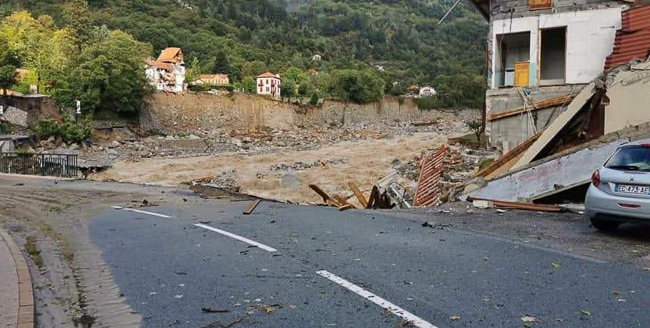
Site of the former petrol station. The village now has no garage and all the cars at the garage being serviced were also lost. Photo by Elizabeth Gabay
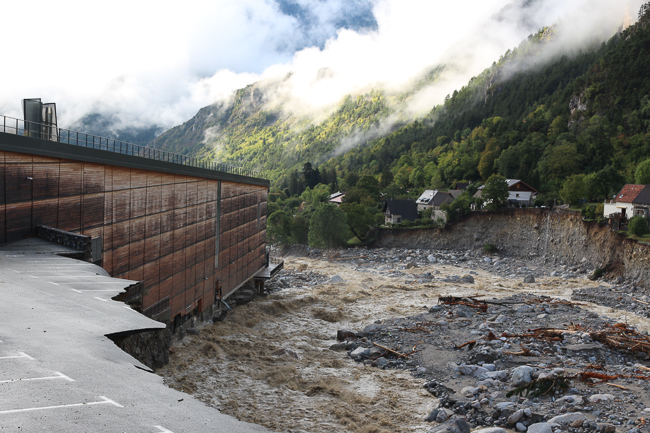
The local sports centre, Vésubia, was built four years ago and had the highest indoor climbing wall in Europe, indoor canyoning, spa and pool. The car park was completely swept away with the few cars left having to be winched out. The theory is that the angle of the sports centre, saved the village because it directed the river away from the village. They are now working to save the foundations, and clean out all the mud and rocks from the inside. Photo by Elizabeth Gabay
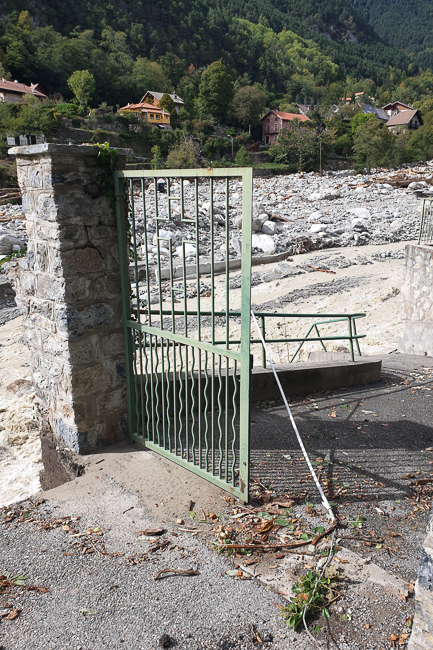
Pictured here is what remains of the local cemetery. It was built in two halves: the older part was higher up surrounded by a high stone wall and that survived but the lower half was washed away and now the gate leads to nothing. Together with the cemeterey in the Roya, over 400 burials were swept away. This will be particularly painful at Toussaint / 31st October when families visit the cemeteries and fill with flowers. (This is still more important than Halloween.) Photo by Elizabeth Gabay
We stared in horror as our village petrol station was swept away – others shouted: “the police station has gone!”, “the brewery has gone!”, “thirty houses up stream have gone!” We watched the car park of the sports centre fall away. “The cemetery is being swept away!” someone shouted. We rushed back home. Shocked. The rain was starting again. With no telephone or internet, we had no idea what was happening and where.
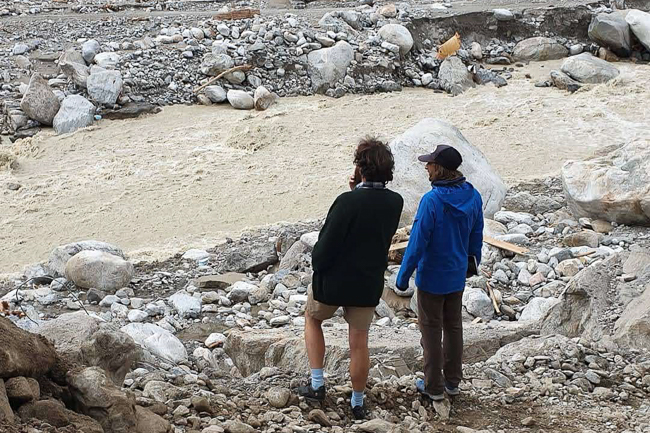
We walked down to the edge of the river where the Pompier (fire station) was completely swept away, not even foundations remained. Next door was the store room for the museum. Photo by Elizabeth Gabay
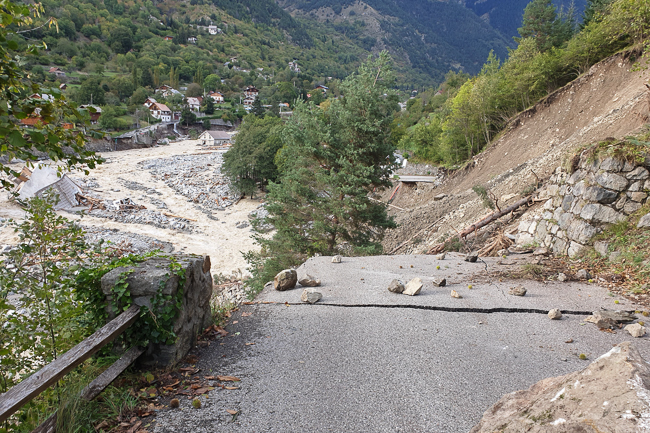
Collapse of the Route de la Madone. Many roads collapsed like this around our village and up and down the valley with the mountain just being swept away under the tarmac, cutting off houses. Some houses are now only accessible on foot trekking across the mountains. Photo by Elizabeth Gabay
Saturday 3rd October. we woke up to bright sunshine and walked into the village. It was full, it was silent. People were crying, blank looks on their faces. The extent of the devastation was enormous. One third of the village swept away. Lines of holiday makers were queuing, waiting to be evacuated to Nice by helicopter. The elderly and ill were also being evacuated. The air was full of emergency helicopters. For the next week we lived in a twilight zone of no electricity, water, telephone and endless helicopters – the services slowly resuming via emergency generators. We climbed a mountain to get a faint signal to send a quick message to my daughter in London, “We are OK”. Over 1000 emergency staff came in, endless debates on whether we should evacuate or not. In the end just over half the population left – many because their homes were no longer safe.
The roads and bridges up the valley and around our village were destroyed and we had become an island. In one day, our little mountain river had become the sixth biggest river in Europe. Almost 2 feet of water had fallen in one day in the village – more rain fell higher up the mountain.
With no electricity or water, getting locals and emergency crews fed was important. Retired local traiteur, Sylvain Laurenti, set up a team of locals to provide a soup kitchen for hot drinks, lunch and dinner for the 100s of rescue teams and locals. The village vets had a stand distributing food for pets and ran a search and find service for lost cats and dogs. The nearby wolf park had been destroyed. One wolf was killed, the rest escaped and needed recapturing.
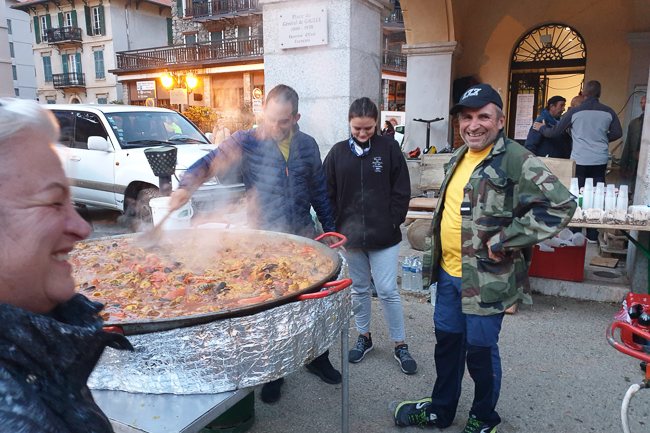
The chef with one of two big pans of paella sent in a gesture of support from Theoule-sur-Mer. Photo by Elizabeth Gabay
On the 6th October the seaside town of Theoule-sur-Mer sent up a jolly Romanian chef who toured the villages of the valley cooking up a giant paella for the emergency services and those still unable to cook. Still unaware of how much the outside world knew of what was happening in our village, this caused a few emotional tears.
On the 7th October our phone signal came back (with hundreds of messages) and we learnt of the devastation had hit the Roya Valley as well. We sat in the square chatting to friends over Sylvain’s salad niçoise and grilled merguez. In the evening I was due to give a Maremma rosé masterclass in Milan, unable to go, and a dodgy connection tethered through my phone, I recorded my commentary on each wine and sent the files, bit by bit to the winemakers. President Macron flew in in the evening.
On 9th October, a week after the storm, the internet was re-connected!!!! And the centre of the village was reconnected to water. I never knew shower envy before – but when we walked into the village for our communal coffee in the square on the 10th, we stared sadly at everyone else boasting clean hair and clothes. A friend came to the rescue – we could use her bathroom during the day and she would do our laundry.
Friends have commented on whether we still had wine to help us through, but the sad fact is, wine dehydrates, and when you have to go and collect bottles of drinking water from the village, or jerry cans of water to wash up and flush the toilet, drinking wine rather looses its allure.
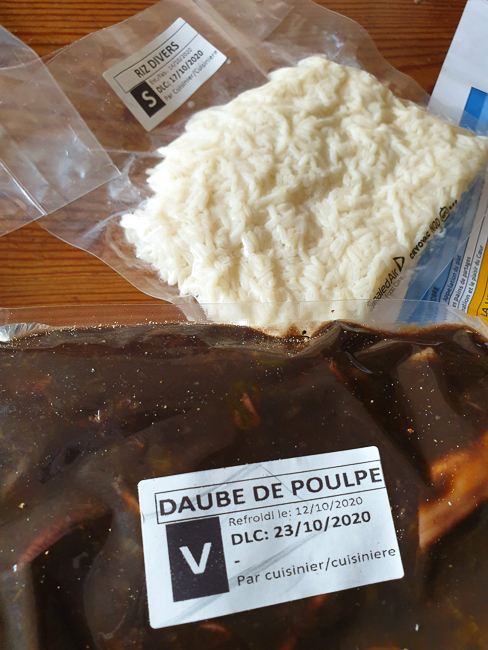
La Chaine des Chefs Daube de poulpes and rice ready cooked – just needing heating. Photo by Elizabeth Gabay
By week two, rough roads and a circuitous route up and over the mountains connected us to Nice. We moved from the emergency atmosphere on to bewilderment of what next. On the 14th October, the mountain village of Isola sent over cauldrons of daube (beef stew) and polenta and our local folk band rustled up some musicians for a convivial atmosphere. It wasn’t a party, but it cheered the soul.
Help has come in many forms. The local brewery, Biere du Comté (Comté du Nice) was washed away and local craft brewers from around the Alpes Maritimes gathered together to make a beer, Conté sur Nous (count on us) with proceeds going to help the brewery re-establish itself.
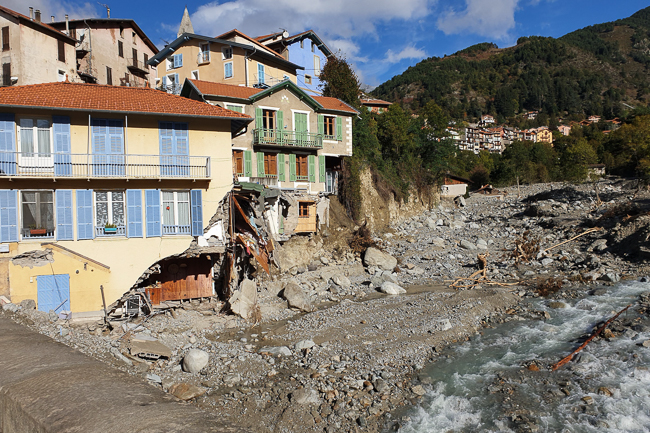
One of the 90 houses lost in Saint Martin. The houses were either swept away or drowned in stones, water and mud. Other houses have found themselves on the edge of cliffs, the land swept away from underneath them and are no longer safe or accessible. Photo by Elizabeth Gabay
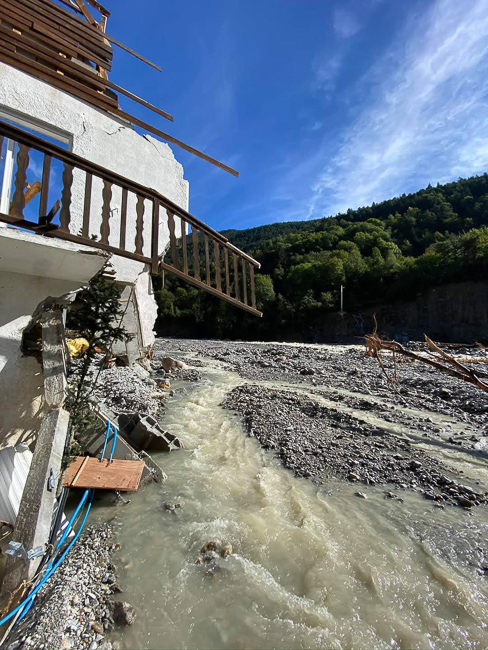
Houses at the bridge at the entrance of the village. One house was washed away and the owner came to stay with us until she was evacuated. Recently widowed, she was just settling into her new small flat and now she has lost everything – photos, clothes, memories. The other two houses have lost their bottom floor and are now very unstable and will probably need to be demolished. To the right is the start of the old medieval village and they are now trying to build up a support wall to protect that side of the town. Photo by Elizabeth Gabay
The mountain valleys behind the Côtes d’Azur are the soul of the region, with many people who live on the coast having family roots in the small villages. One reason this region voted to join France in 1860 was because so many mountain villagers found work in the restaurants and hotels along the French coast. Many still own family homes up in the valleys, many others come up to the mountains for holidays, the villages swelling in size every weekend.
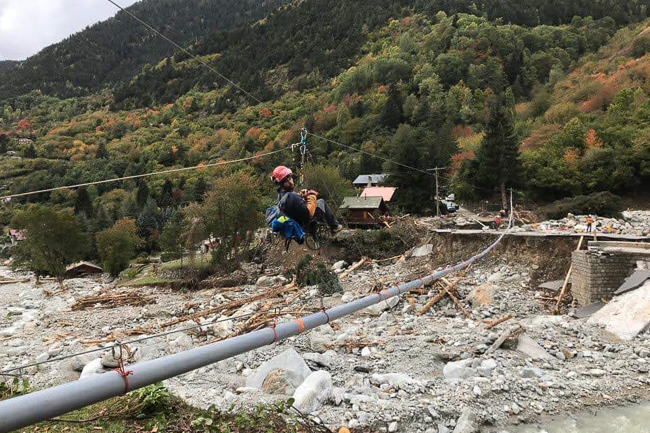
The bridges and roads were swept away up and down the valley. Here at Pont Maissa the avalanche of rocks destroyed many houses too, and in some places have left thick piles (3 feet) of rocks so access to houses is almost impossible. To cross the river, the rescue people rigged up zip wires. Photo by Elizabeth Gabay
With this emotional link, many have wanted to help the villages, but the Vésubie has been closed to everyone but residents as the roads are still fragile and only emergency services and deliveries such as food, clothes and medical supplies have been coming through. Restaurants are still closed, hotels have been taken over by emergency crews. After two weeks one café has re-opened. Like everywhere else in the world, we had already been hit by Covid. Restaurants had been closed during March and April, reopening with outdoor dining only from May, but now with rising figures again, and cooler weather and diners less willing to eat outside, restaurants are closing again. A number of restaurants in Nice and surrounding towns have organised fund raising dinners for the valleys hit by the storm, but with this tough economic atmosphere, help from some of the top restaurants in the region, directly in the villages, was not anticipated.
The Chain of Chefs
On the 10th October, chefs Mauro Colagreco of Le Mirazur in Menton and Christophe Bacquié of the Hôtel du Castellet near Bandol (both 3 Michelin stars), realised they wanted to help – but were unsure how. In April, Colagreco had already helped out medical workers caring for Coranavirus patients by offering seventy-five meals, twice a week. The two chefs contacted fellow chef Philippe Joannès from the Société des Bains de Mer (SBM) in Monaco, and president of the “Meilleurs Ouvriers de France” in the south east, to brainstorm ideas. They each rang up a colleague to help and asked everyone to contact another chef – to form a chain of chefs. Each chef contacted a colleague creating a chain of thirty-four chefs. (Michelin stars indicated)
The participants were:
- Christophe Bacquié, Hôtel du Castellet ∗∗∗
- Jean-François Bérard, Hostellerie Bérard, La Cadière d’Azur
- Cédric Campanella, Chef Pâtissier Société des Bains de Mer à Monaco
- Mauro Colagreco, Le Mirazur ∗∗∗, Menton
- Jérémy Czaplicki, Hôtel Ile Rousse ∗, Bandol
- Julien Diaz, Saisons à Marseille ∗
- Arnaud Donckele, Cheval Blanc ∗∗∗, St Tropez
- Noëlle & David Faure, SensÔriel, Nice
- Arnaud Faye. La Chèvre d’Or ∗∗, Eze
- Michel Hulin, La Cabro d’Or, Baumanière, Les Baux-de-Provence
- Philippe Joannes, Société des Bains de Mer, Monaco
- Franck Lafon, Café de Paris, Monaco. Lafon comes from the village of Tende in the Roya, on the Italian frontier
- Stéphane Lelièvre, Les Pins Penchés, Toulon
- Lionel Lévy, Alcyone *, Intercontinental Hôtel-Dieu, Marseille
- Dominique Lory, Le Louis XV Alain Ducasse ∗∗∗, Monaco
- Jacques Maximin (Chef consultant)
- Gérald Passédat, le Petit Nice ∗∗∗, Marseille
- Nicolas Pierantoni, L’Hostellerie de l’Abbaye de la Celle ∗, Brignoles
- Michel Portos (Chef consultant)
- Patrick Raingeard, Le Cap Estel ∗, Eze
- Frédéric Ramos, L’Azzurra Kitchen, Monte Carlo
- Marcel Ravin, Blue Bay ∗, Monaco
- Fanny Rey, L’auberge de St Rémy ∗, St Rémy de Provence
- Julien Roucheteau, La Réserve de Beaulieu ∗
- Richard Rubbini, Le Sporting, SBM, Monaco. Rubbini comes from the Vésubie.
- Guillaume Sourrieu, L’Epuisette ∗, Marseille
- Thomas Subrin, Chef Boulanger SBM, Monaco
- Ken Thomas, Chef pâtissier, SBM, Monaco
- Ludovic Turac, Une Table au Sud ∗, Marseille
- Glenn Viel, L’Oustau de Baumanière ∗∗∗, Les Baux en Provence
- Alain Llorca, Restaurant Alain Llorca ∗, Le Colle sur Loup
- Cedric Campanella, patisserie SBM, Monaco
- Virginie Basselot, Le Chantecler ∗, Hotel Negresco, Nice
- Mathias Dandine, La Magdaleine ∗, Gémenos
Map showing the location of the restaurants and chefs that participated in the “chain of chefs” effort. The”chain of chefs” support came from as far as 300km (186 miles) from the relief.
On the 11th and 12th the chefs project was publicised in the press. By the 14th October they had worked out the logistics. Each chef was asked to prepare a starter, a main course or a dessert for 100 people, while the bakers were asked for bread. Each dish had to be packaged suitably to be easily transported up to the villages. Together they prepared 3000 meals cooked for volunteers and disaster victims. The chefs asked their suppliers to help to supply products and transportation. Refrigerated trucks were loaned free of charge by a number of companies, with considerable support from the company Balicco. These trucks toured the region collecting the meals and delivered to the central collection point, the Palais Nikaïa in Nice, by Thursday October 15th. On Friday 16th, the meals were delivered to the villages, by either trucks or helicopters, depending on the volume to be transported and accessibility.
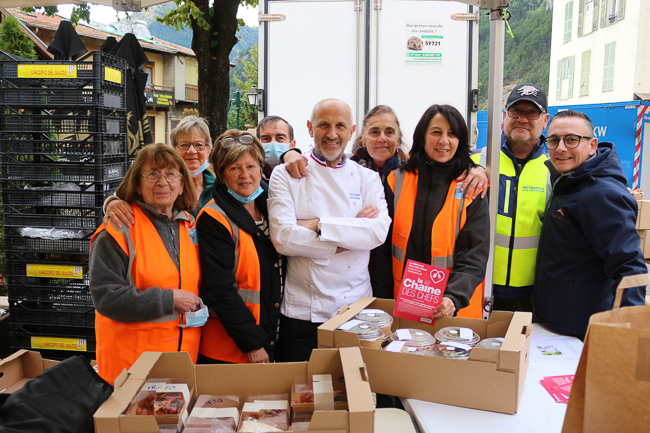
The team of locals who helped Philippe Joannès (center) pack up and distribute the meals. Photo by Elizabeth Gabay
Friday 16th, bang on 1pm, Philippe Joannès arrived with a small refrigerated van full of meals. A team of locals were on hand to distribute the meals and locals and emergency service crews sat in the sunshine to enjoy the gourmet food. Every village had a different combination of meals. Wine was not included – maybe not a sensible idea given that many of those eating were working in the emergency services, but we brought our meals home and benefited from the range of Hungarian and Austrian rosés I had been tasting during the week.
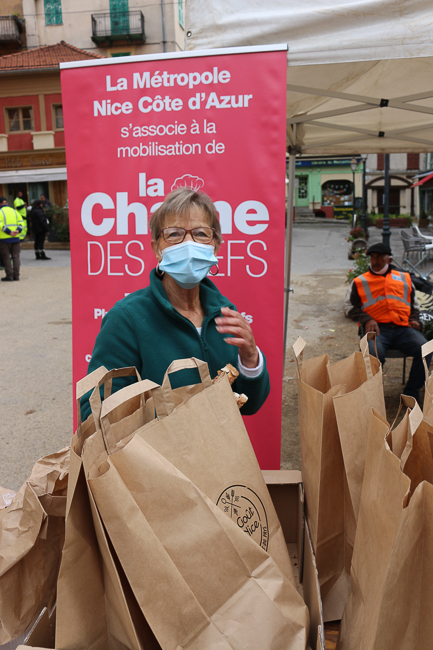
La Chaine des Chefs Genievieve helping out with handing out the bags with meals. Photo by Elizabeth Gabay
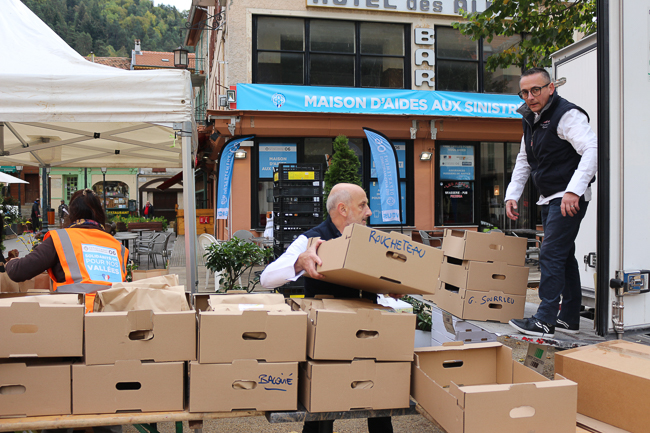
La Chaine des Chefs boxes of carefully packed food arriving in a refrigerated van. The only way to drive up to St Martin was, on this day the long way round, up and over the route des Grands Alpes! Photo by Elizabeth Gabay
The range of meals for the Vésubie (the meals we had in bold) included:
- Christophe Bacquié (Hôtel du Castellet) – Blanc de volaille rotie aux épices, penne rigate, olive, basilic. This was beautifully seasoned – I thought possibly cinnamon or five spice with the chicken. Semi sun dried tomatoes added to the sweet intensity, the olives gave salinity.
- Jean-François Bérard (Hostellerie Bérard) – La Morue en fine brandade, legumes du pot
- Mauro Colagreco (Le Mirazur) – Daube de boeuf aux écorces d’Agrumes
- Jérémy Czaplicki (Hôtel Ile Rousse) – Risotto Arborioi au beurre de clementines potiron et éclat de Châtaignes
- Julien Diaz (Saisons à Marseille) – Daube de boeuf limousine d’Aveyron olives, câpres et polenta cremeuse au beurre fume. I think this was the creamiest polenta I have ever had – beautifully creamy with tender beef.
- Noëlle & David Faure (SensÔriel) – Le chocolat au coeur confit de pommes gingembre, cacao passion
- Arnaud Faye (La Chèvre d’Or) – Saumon fumé maison, quinoa gourmand citronné
- Michel Hulin (La Cabro d’Or) – Suprême de volaille label rouge roti, roseval et morilles
- Franck Lafon (Café de Paris) – Daube de boeuf mijotée aux petits oignons et pommes grenailles
- Lionel Lévy (Alcyone) – Escabeche de maquereau à l’orange.My husband had this. The diced vegetables, largely carrots, were lightly cooked and just the right amount of crunch, the filets of mackerel very fresh and no bones.
- Dominique Lory (Le Louis XV) – Panettone du Louis XV Alain Ducasse à l’Hotel de Paris
- Jacques Maximin (Chef consultant) – Gratin de macaronis à la Parmigiano
- Gérald Passédat (le Petit Nice) – Palais chocolat ‘Passedat aux passion’
- Nicolas Pierantoni (L’Hostellerie de l’Abbaye de la Celle) – Gâteau Basque aux prunes de Brignoles
- Michel Portos (Chef consultant) – Le boeuf Bourguignon comme Michel l’aime
- Patrick Raingeard (Le Cap Estel) – Epaule d’agneau confite, jus épices, polenta aux petites olives
- Frédéric Ramos (L’Azzurra Kitchen) – Supreme de volaille, crème de truffe
- Marcel Ravin (Blue Bay) – Curry de volaille au lait de coco et riz Madras
- Fanny Rey, (L’auberge de St Rémy) – Brandade de Maigre de Mediterranée, aïoli citonné et Poutargue de Martigues
- Julien Roucheteau (La Réserve de Beaulieu) – Blanquette de veau sur riz aux legumes, joue de boeuf braisé à la citronelle sur une ecrassé de pommes de terre
- Richard Rubbini (Le Sporting) – Poulpes de roches en daube au Barolo et riz blanc
- Guillaume Sourrieu (L’Epuisette) – Saumon aux girolles et herbes fraî.My husband’s second dish. The thick, rich mushroom sauce had whole girolles with the pieces of salmon perfectly cooked.
- Ken Thomas (Chef pâtissier) – Fraîcheur éxotique, moelleux noix du coco, confit mangue passion
- Ludovic Turac (Une Table au Sud) – Volaille jaunes rôties au romarin, risotto d’herbes et pastis
- Glenn Viel (L’Oustau de Baumanière) – Ris de veau crème, champignon du moment, Tarte amandine aux poires
- Alan Llorca (restaurant Alain Llorca) – Veau rôtie au thym, traditional gratin dauphinois
- Cedric Campanella, patisserie SBM – Pralinée pignon, crémeux lactée et crumble confit de baies rouges
- Virginie Basselot, Hotel Negresco – Mousse Lactée, marmalade d’abricot et biscuit noisettes
- Mathias Dandine, La Magdaleine – Saumon, déclinaison de fenouil, sauce vin blanc
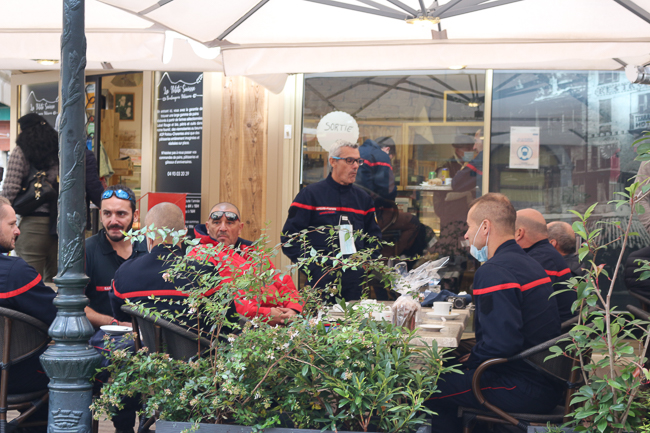
La Chaine des Chefs provides for rescue crews who enjoy. a Michelin star lunch. Photo by Elizabeth Gabay
The chefs had wished to show solidarity, to bring cheer to the villages, to support them as they recover from the devastation and, judging by the smiles on peoples’ faces, we all appreciated our taste of gourmet cuisine.
Once again, the hospitality industry (restaurants, food producers, wine and beer producers) have shown its value in society, supporting those in need. Not just a luxury, they are very much part of our society, bringing people together.
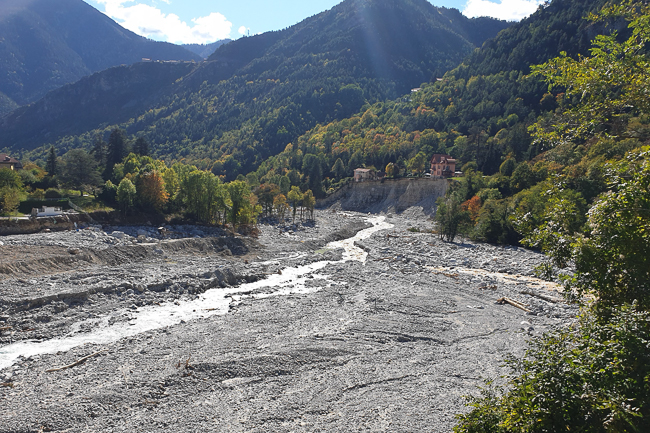
This is the confluence of the two rivers. La Madone and le Boreon. In this photo the rivers have resumed their normal size. On the weekend of the storm, where there are stones now was a raging muddy torrent. Prior to the storm you could hardly see the river as it flowed through forests and gardens. On the far side of the river you can see a house on the edge of the cliff. This was a beautiful Belle Epoque house which had recently been bought and lovingly restored. The owner said it was a night from hell as she watched her garden fall away ever nearer to the house. She was also busy trying to protect two elderly neighbours. Photo by Elizabeth Gabay
Stop press: On the 19th normal deliveries were resumed, including four boxes of rosé to taste! 20th we were finally connected to water!!!

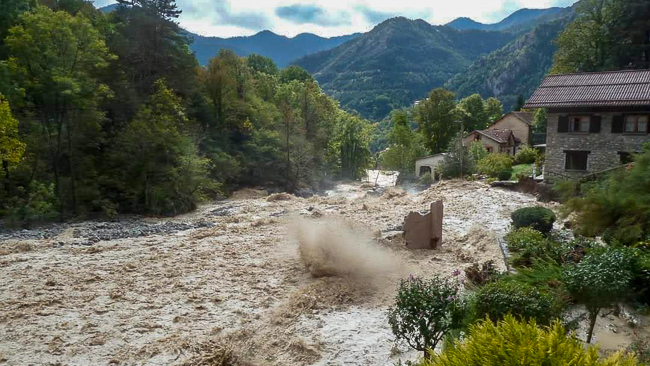
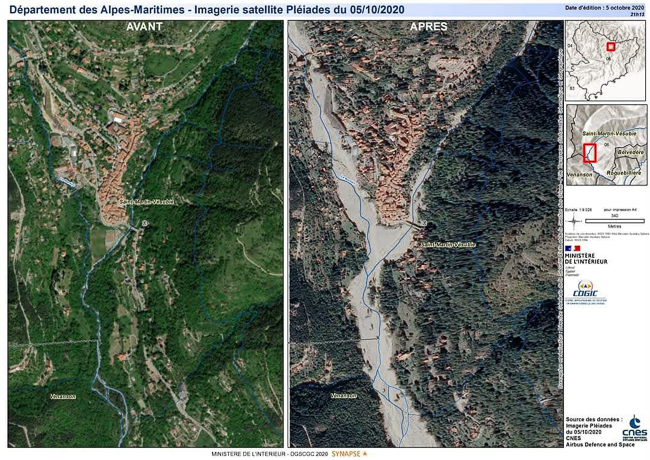
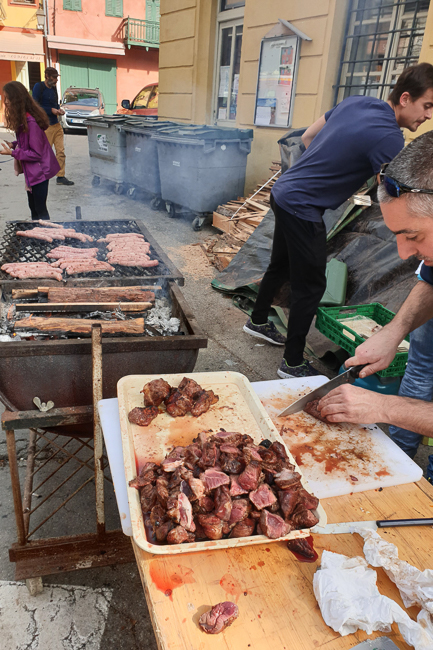
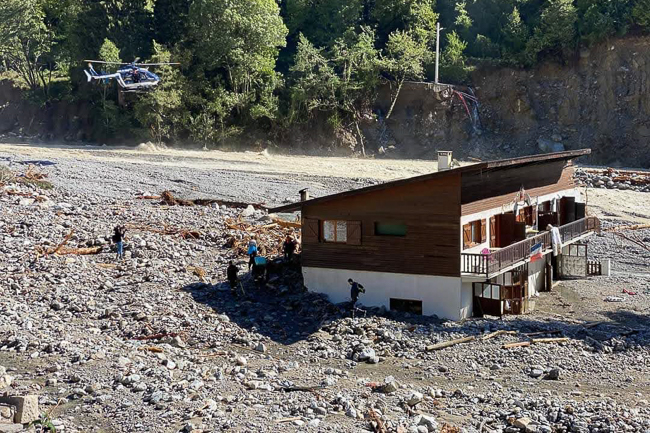
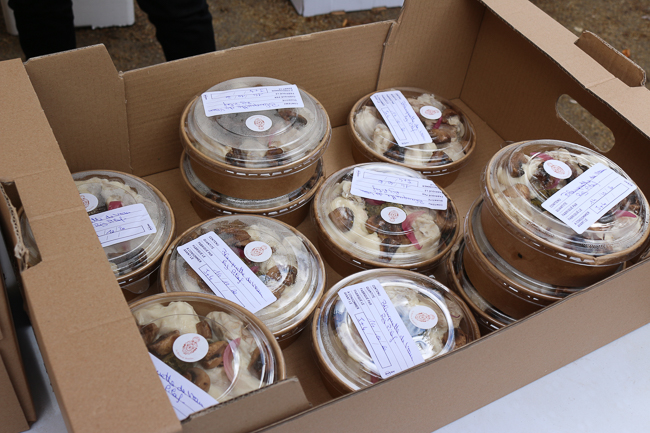
WAOUH !
A pretty amazing story — triumph over tragedy!
This is a superb article written about a devastating incident that recently occurred in a bucolic setting known for its beauty, history, and events. Despite the profound losses the folks have suffered and the devastation of their surroundings, this article exudes a warm, caring generosity of humanity taking cate of one another in exemplary ways in the face of disaster. It is similar In ways to the experiences we’ve had in the western US as the wild fires continue, even the whir of helicopters. The excitement of the Tour and boom, life changed in a blink. That seems to be the theme of 2020. You have written from a perspective a perspective that I find most refreshing and admiral balancing shock with hope as you cite the details of that progression. Thank you! I love this blog❣️
It is a wonderful article — full of details of the devastation but balanced with the goodness of humankind! And a great restaurant list!
Patti, Did you note that you have been to one of those Michelin star restaurants on two occasions?
Wow—I hardly have words, first on the incredible devastation and then on the tremendous people who have gathered to restore hope. Thank you for this captivating article. I have such love and heartfelt emotions for the people of France.
It is a rollercoaster of a read, isn’t it?! Make a copy of that restaurant list for your next trip to France!
When we read fo the flooding in that region, I had no idea that it included where you live, Elizabeth. The devastation is just horrific, but the heart of the region is inspiring. So wonderful to read of the generosity of heart and gifts… Thanks for sharing such a personal and emotional story.
So true, David. It warms your heart, doesn’t it?! Elizabeth did a super job!
Chère Susan,
What a gorgeous image of a very rural scene in mountains of Provence!
Thank you for this and for the info on PANDAS which I was unaware of.
I say again how deeply sorry I am for the loss of your beloved daughter, a victim of this insidious disease.
For the first year since 2001, I was not able to sojourn in ‘La douce France’. Made my reservation in January for 5 weeks, April-May. Mais hélas, all was cancelled in March. No getting on a plane for me this year!
Hope y’all are staying safe and in good health. Happy fall!
Amitiés,
Henry